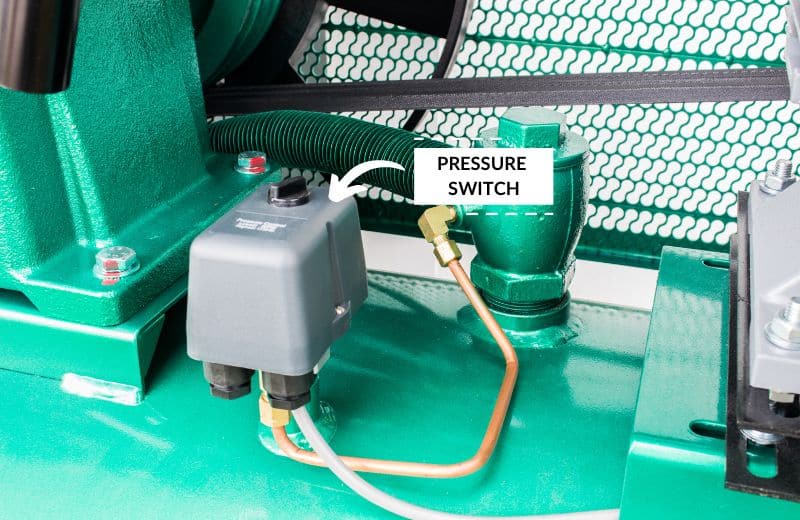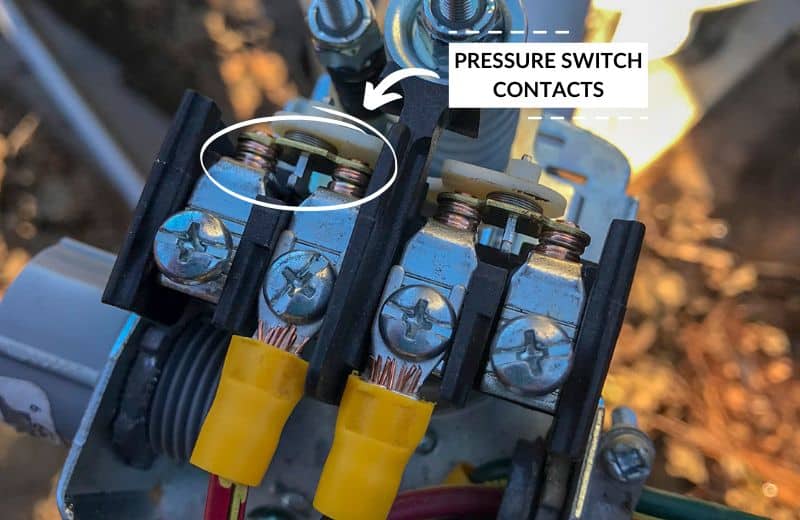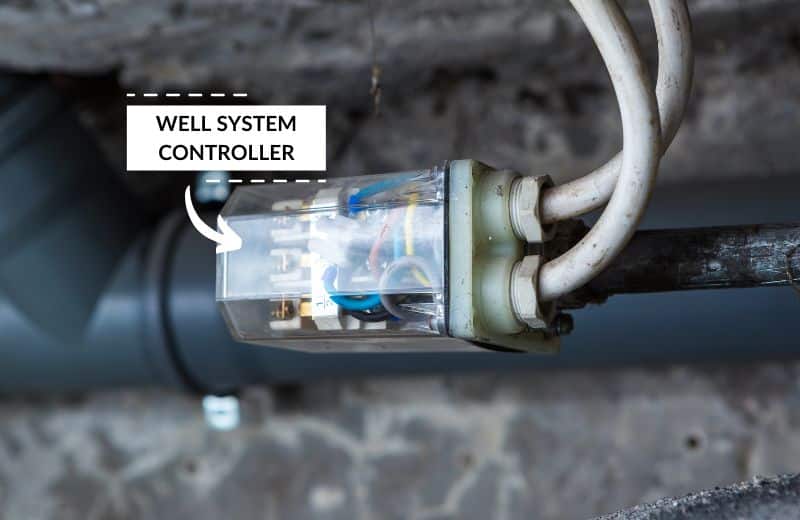Your well pump’s pressure switch is an important feature of your well, and if it fails, your well may be unable to function properly.
In this guide, I’ll be sharing why a well pump is needed, why it might fail, signs of a failing pressure switch, and how to tell if your well pump pressure switch is bad.
Table of Contents
🌡️ What Does a Well Pump Pressure Switch Do?
A well pump pressure switch measures the water pressure in your well system and tells your well pump to start or stop pumping based on this measurement.
There are two pressure settings that a pressure switch will detect, measured in PSI: a cut-in pressure, and a cut-off pressure. You should find these two numbers on the actual switch. Usually, they’ll be 20-40, 30-50, or 40-60 PSI. You can typically adjust these numbers to suit your requirements.
The lower number is the cut-in pressure. When pressure in the water system drops this low, the pump will switch on, and begin to fill the pressure tank. The higher number is the cut-off pressure. When the pump has increased the pressure to this number, it will know to switch off.
You should find your well pump pressure switch in the vicinity of your well pump system, whether that’s installed in your basement, your garage, or its own separate housing.
Keep in mind that submersible pump systems have a slightly different setup, and the switch is usually located away from the pump – typically on one of the pipes leading into your pressure tank. Jet pumps, on the other hand, typically have the pressure switch somewhere on the pump itself.
📝 Reasons a Pressure Switch Can Fail
The main reason for a failing pressure switch is corrosion. A pressure switch uses springs, which help detect and set water pressure. Electrical wiring is also required to switch the pump on and off.
As time passes, the wiring in your pressure switch will begin to corrode. The springs may also become loose, and contacts may rust until they detach from the system, preventing the pump from working at all.
Water pressure switches are usually housed in plastic casing, but this won’t stop the pump from being damaged by the sun, humidity, or below-freezing climates. It’s likely that you’ll need to replace your pressure switch several times throughout your home ownership.
Insects, like ants and spiders tend to be attracted to pressure switches especially when they are located outside. The dry cover acts as an insect “shelter” when it rains or temperatures drop, so be sure to keep up with pest control measures around the area to prevent the insects from causing contact issues within the pressure switch.
🔧 Signs of a Failing Pressure Switch
Now we know why a pressure switch is needed, and the reasons why it can fail, it should be easier to detect signs of a failing pressure switch. Look out for the following issues if you think your well water pump pressure switch needs replacing or repairing:
- The pump won’t switch on, and you have no water
- The pump is stuck in a continuous cycle
- The pump is operating, but water pressure is lower than it should be
- The pump doesn’t kick in at the required cut-in pressure
Keep in mind that these issues don’t exclusively mean that you have a problem with your well pump pressure switch. They could be a sign that you have an issue with another feature of your well, such as the water pump itself, or the pressure tank.
📌 How to Tell if Your Pressure Switch is Bad
Before deciding that you need a new well water pump switch, it’s worth troubleshooting your well system to determine whether your pressure switch is to blame.
Let’s look at the step-by-step process of troubleshooting a well pressure switch.
Switch off the Power
For your well system to be safe to access, you need to prevent power from traveling to the well pump system. The last thing you want is to accidentally touch a live wire at the same time as holding a grounded water pipe.
To turn off your electricity, flick the switch at your circuit breaker. An alternative option is to remove the circuit breakers entirely. If you’re not sure whether you’ve disconnected the power supply, use a neon circuit tester to check.
The well pump itself might be an issue if the circuit is tripping continuously, and you may need to look into pump repair or replacement.
Find the Well Switch
You should find the pump switch connected to the pump or pipe supplying the pressure tank. Unscrew the top screw cap of the pump covering, using plumbing pliers if you need them.

Look for Leaks
A leak can be the most obvious sign that something isn’t right. If you notice water leaking out of the switch, it may simply need tightening. Use your plumbing pliers to do this. An internally leaking switch is a more complex issue, and a sign that the switch is bad.
Assess the Contacts
I mentioned earlier that contacts can rust and detach from the pump over time. Pry apart the contacts and pull away the internal spring. The switch should close, and water pressure should increase. If not, it probably needs a repair or replacement. You can turn your power on again if the switch does close.

Let the Pump Cycle
Next, with your power back on, head to a faucet nearest to your pump and open it. Let the pump run a complete cycle.
If the switch fails to close in the case of low water pressure, it suggests the internal spring should be replaced. Make sure you don’t touch the energized water, and switch off and unplug your power supply if you see sparks.
Check the Pump’s Connection
Keep the power on and the switch’s cover removed. Use a heavy item, like a screwdriver handle, to bang the tube below the switch. This will move the electrical components inside. If banging the tube causes the pump to switch on, and you see sparks, it’s likely that there’s an issue with the pressure switch.
If you don’t notice a spark, you might have an issue with the well system’s controller. The contact surfaces between the electrical components might be corroded or burned, which can prevent them from forming a proper connection.

Assess the Electrical Contact Surfaces
Pull apart the electrical contact surfaces and look them over. If you notice burns, or you can feel pits in the discs, you need new contacts.
A quick fix is to smooth out the areas that are pitted or burnt with an emery board or nail file. Keep in mind that this is only intended as a temporary fix, and you should work as quickly as possible to replace the switch entirely.
❔ Can You Replace a Pressure Switch Yourself?
Replacing this component in your well is fairly quick and easy, taking less than an hour. It’s an affordable repair, too, especially if you decide not to call a professional for the job.
However, if DIY isn’t your strong point, or you’re still not entirely sure whether you have an issue with your well water pump, tank, or any other component, you may prefer to seek a second opinion from someone who knows their stuff.
A professional pump repair can cost between a few hundred and a few thousand dollars, depending on exactly which component(s) you need to replace. Ask around for quotes before you settle on one person for the job.

I did not have water this morning. After I read your article and examined my pressure I saw that my problem was a burnt connection. After using a 220 grit sand paper and turned the power back again my system was working again. As you said this is just a temporary fix. And so I ‘m going to purchase a new pressure switch.
Thank you for the info you’ve provided.
Thanks for sharing your experience, I’m glad you found the info helpful!
I appreciate you letting us know that the pressure switch of our well pump can start to fail due to corrosion since the springs will end up becoming loose and contacts will rust until they detach from the system. It seems like this is the issue we are currently dealing with at home since our water well pump suddenly stopped functioning this morning out of nowhere.
Very good information. Thank you for sharing.
Great to hear it was helpful!